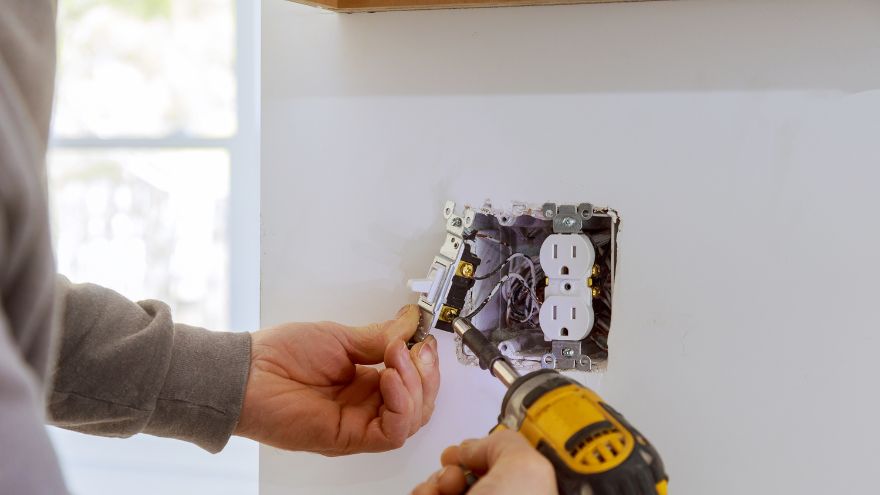Correct installation of electrical sockets is not only a matter of aesthetics, but also safety and comfort of use. In this article, we will discuss at what height to install sockets, what are the different types of installation sockets, and how to properly plan the layout of electrical sockets in different rooms. These tips will be useful for both professional installers and people planning to modernize their home on their own.

Check the electrical outlets at the Onninen wholesaler
Installation height of sockets on the floor
The height at which sockets should be mounted depends on the purpose of the room, and consequently, on how the sockets are used as power sources. The rules for placing sockets in the wall are quite clear, and all of them are intended to provide comfort to users during use.
 The standard height of electrical sockets is 20 to 30 cm from the floor. This is the optimal height for safety and convenience of connecting everyday devices (bedside lamps or chargers).
The standard height of electrical sockets is 20 to 30 cm from the floor. This is the optimal height for safety and convenience of connecting everyday devices (bedside lamps or chargers).
Plug sockets mounted too low above the floor may be susceptible to mechanical damage, while sockets located too high may make access difficult. Connected devices may be too high or the power cord may be too short.
Let us explain that installation sockets differ in their mounting method and purpose:
- Flush-mounted sockets – mounted in installation boxes, aesthetic and more resistant to damage.
- Surface-mounted sockets – easy to install, ideal for technical rooms.
- Kitchen sockets – specially designed to operate household appliances, mounted in furniture or as strips.
During installation, the rules for placing sockets must be followed, using appropriate electrical sockets that meet safety standards.
It is also important that sockets and light switches are located in places free from obstacles, which ensures their comfortable use in everyday situations.
How high should sockets be above the countertop?
 In the kitchen, the installation height of electrical sockets above the worktop is usually 100–120 cm from the floor level.
In the kitchen, the installation height of electrical sockets above the worktop is usually 100–120 cm from the floor level.
This height takes into account the convenience and safety of connecting home appliances:
- dishwashers;
- refrigerators;
- mixers;
- coffee machines.
Thanks to the right location, it is easy to keep order and use kitchen equipment conveniently. When planning the layout of sockets in the kitchen, you should consider the number of devices used at the same time and their layout. It should not be forgotten that some kitchen devices, such as a refrigerator or microwave, require free space from the wall to ensure ventilation.
The height and location of electrical outlets are designed to provide:
- Convenience of use,
- Protection against mechanical damage,
- Minimizing the risk of electric shock in rooms with increased humidity levels (e.g. bathroom or kitchen).
Sockets and switches must not be installed in the immediate vicinity of water, as this poses a serious risk to the safety of users.
How far should sockets be from the sink?
In accordance with safety requirements, plug sockets in the bathroom cannot be located less than 60 cm from water sources. Placing the socket (power source) too close to the washbasin or sink leads to the risk of electric shock.
 To ensure safety, it is recommended to use sockets with a flap, which additionally protect against moisture. When choosing installation sockets, it is worth paying attention to models with the IP44 marking or higher, which ensures resistance to moisture.
To ensure safety, it is recommended to use sockets with a flap, which additionally protect against moisture. When choosing installation sockets, it is worth paying attention to models with the IP44 marking or higher, which ensures resistance to moisture.
Each type should be adapted to the needs of a specific room and conditions of use.
Regardless of the location, correct installation of an electrical outlet requires the right tools and adherence to safety rules:
- Plan the location of electrical outlets;
- Check at what height the sockets are to be installed;
- Make sure the power is disconnected to avoid electric shock.
- Connect the wires according to the markings: phase, neutral and ground.
- Check that the cables are properly seated and tightened.
When choosing a socket , it should be selected to suit the needs of a specific room and the conditions of use. It is worth using high-quality installation sockets that ensure reliability and durability.
The installation of electrical sockets should be in accordance with the provisions of the Building Law and PN-IEC standards. Electricians are required to use appropriate tools, materials and follow procedures to ensure the safety of the installation.
The correct arrangement of electrical sockets in the home requires taking into account both practical and safety aspects. It is worth using high-quality installation sockets, such as those available at the Onninen wholesaler, which guarantee reliability and durability.
We encourage you to familiarize yourself with the offer of the Onninen wholesaler, where you will find a wide selection of electrical sockets, light switches, and other elements of the electrical installation. Let us add that each socket available in the offer meets all safety standards! Choose proven solutions that will meet the expectations of even the most demanding installers!